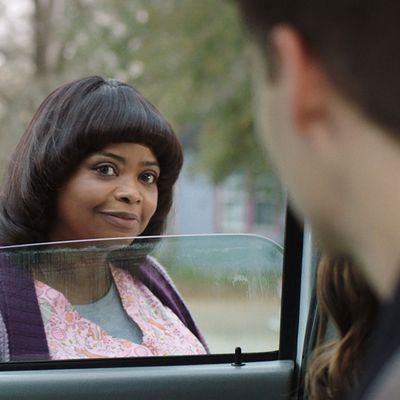
As Ma rushes to its climax, there’s a moment (fairly spoiler free — it’s featured in the trailer) when the racial animosity that powers this muddled slasher film becomes undeniable. Sue Ann, a methodical psychopath played with a consuming madness by Oscar-winning actor Octavia Spencer, is picking apart the teenage objects of her anger one by one. She comes to the only black kid in the group, and instead of using another mundane household item to torture him, she simply paints his face white. “There’s only room for one of us,” she says with panache, a line that earned hearty guffaws from my theater’s audience. The moment rightly calls attention to the tokenism that powers Ma, but like the remainder of the 99-minute film, it never really unpacks the practice.
Ma follows Sue Ann — a lonely, malevolent veterinary aide living in the rural area where she grew up — as she ingratiates herself with her town’s teenagers. She buys them beer and transforms her basement into a teen oasis fit for their alcohol-soaked parties, treating them with a mix of stomach-churning attraction and ire. In contrast to Sue Ann, these kids aren’t exactly presented with innovative distinction. They’re blandly charismatic, capable of maintaining a sufficient rapport with one another — there’s Haley (McKaley Miller), the loquacious mean girl; Darrell (Dante Brown), the black friend who regards Sue Ann warily; Chaz (Gianni Paolo), the rambunctious class clown; and Andy Hawkins (Corey Fogelmanis), whose sympathetic backstory involves the loss of his mother to cancer and a loathsome, aggressive father (Luke Evans). It’s Maggie (Diana Silvers), the tenderhearted new girl in town, whose coming-of-age story about wrestling with her mother’s influence in her life, who is the most fleshed out.
Sue Ann — or “Ma,” as she encourages the kids to call her — is curiously drawn to Maggie and, in turn, Maggie’s boyfriend. Ma, we come to understand, is a black woman so fiercely obsessed with whiteness she’d kill to attain it, even by proxy. She loathes Maggie and the other young white girls — drugging them, stealing their jewelry, pining for admiration from the men in their lives. It all has something to do with Sue Ann’s high-school backstory, involving a racialized moment of sexual humiliation — a truth that trickles out over time.
Unfortunately, the tragedy of Sue Ann’s life remains largely unaddressed. The movie is too confused about who its characters are and what it wants to be to mine the potential complexity of the mammy archetype at its center — or indict the whiteness that created it. Even the film’s setting feels uncertain. It’s evident that it takes place in Mississippi, but director Tate Taylor (of The Help infamy) and cinematographer Christina Voros choose to make the culturally ambiguous town gray and dingy rather than verdant. The uncanny location makes the decision to not unpack the racial malignancy of the community all the more galling.
There are some decent moments of body horror in Ma, when items in the domestic sphere — irons, needles, threads — become instruments of violence. Figures crumple under cars, dogs succumb to poison, lips are sewn. But Sue Ann’s revenge arc isn’t strong enough to mark this a true slasher flick, and the filmmakers perspective on Maggie’s story line is too blinkered to work as a coming-of-age fright fest. The true horror of the film should be in its racial landscape, but Taylor doesn’t paint a clear enough picture. That the story ends with a white protagonist and motherhood exalted is as heroic as it is damning. Ultimately, to borrow a phrase from writer Michele Wallace, Ma is too wistfully hegemonic to truly work.
Still, Ma is intermittently entertaining thanks to the keen work of its casting director and a handful of precise performances. The supporting cast reminds me of 1990s blockbusters like Air Force One, consisting of a corps of character actors who animate the story even when the script by Scott Landes does not. The great Juliette Lewis plays Maggie’s mom, Erica, who initially treats her daughter like a friend before smartly becoming overprotective. Bad dad Luke Evans hits the right blend of scuzzy and angry. Missi Pyle plays his drunken girlfriend, introduced when she’s giving him a blow job in his car. In the most inspired casting move, Oscar winner Allison Janney plays the no-nonsense, foulmouthed veterinarian who employs Sue Ann. The fact that we’re able to get to know these lesser characters as they go about their days in a small town makes the horror that comes later more effective despite Taylor’s pedestrian direction — because we care about them.
But it’s Octavia Spencer who is most striking, filling the story with an immense, glowering energy. Audience suspense levels rise and fall at the twitch of her face, which shifts from kindly to menacing at a clip. Spencer recognizes the twin impulses of revenge and longing, and she expertly indulges them in smaller scenes, like when Sue Ann is getting ready for what she thinks is a date. She studies her reflection like she studies the teenagers now trapped in her web of deceit: intensely. It’s a delicate balance, and at times Spencer makes the mistake of going for humor rather than pathos (e.g., the aforementioned decision to paint Darrell white), but for the most part her performance is beguiling and frightening. Through her, Ma suggests what might happen when the mammy figure’s love of whiteness curdles into a violent obsession. Too bad it only hints at the answer.


